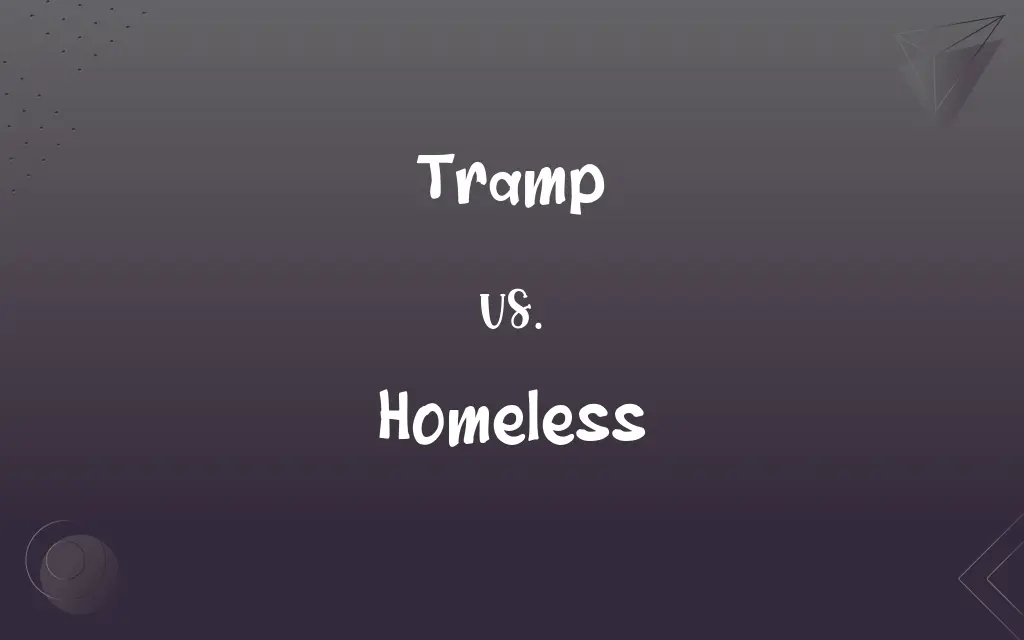Tramp vs. Homeless: What's the Difference?
By Aimie Carlson & Janet White || Updated on March 3, 2024
A tramp is someone who travels from place to work or beg, lacking a permanent home, whereas homeless refers to someone without a stable residence.

Key Differences
Tramps are often characterized by their wandering lifestyle, moving from one place to another, often working odd jobs for survival. On the other hand, homeless individuals may stay in one area but lack a secure and permanent residence, possibly relying on shelters or temporary accommodations.
While tramps may choose a nomadic life for various reasons, including a desire for freedom or an aversion to conventional employment, homelessness is typically involuntary, stemming from financial, social, or personal crises.
Tramps historically were part of a subculture that embraced a transient lifestyle, often with a set of norms and codes among them. Whereas, homelessness is a social issue faced by individuals who are unable to maintain a permanent and safe dwelling due to various socioeconomic factors.
The term 'tramp' can sometimes carry romanticized or adventurous connotations, reflecting a choice to live outside societal norms. In contrast, 'homeless' is often associated with hardship, vulnerability, and a need for societal support and intervention.
Comparison Chart
Definition
A person who travels from place to place, often to work or beg, without a permanent home.
An individual who lacks a stable, permanent, and adequate residence.
ADVERTISEMENT
Lifestyle
Nomadic, often by choice, with a degree of freedom in movement.
Involuntary lack of residence, often seeking temporary shelters or accommodations.
Employment
May work odd jobs or beg during their travels.
May face challenges in securing stable employment due to lack of permanent address.
Social Perception
Sometimes romanticized or seen as adventurous.
Often viewed with sympathy, highlighting a need for societal support.
Subculture
Part of a transient subculture with its own norms and codes.
Not typically associated with a specific subculture but a broader social issue.
Tramp and Homeless Definitions
Tramp
Historically, a part of a subculture with its own rules and codes among those who travel.
As a tramp, he adhered to the unspoken rules of the road shared among fellow wanderers.
ADVERTISEMENT
Homeless
An individual without a stable, permanent, and adequate dwelling.
The homeless man spent his nights in a city shelter.
Tramp
A person who travels from place to place without a permanent home, often for work or begging.
The tramp moved from town to town, picking up odd jobs along the way.
Homeless
Homelessness can affect anyone, disregarding age, gender, or background.
The documentary highlighted the stories of homeless families struggling to find stability.
Tramp
Someone who leads a wandering lifestyle, often by choice, outside of societal norms.
He chose to live as a tramp, experiencing freedom on the open road.
Homeless
Often associated with people living on the streets, in shelters, or in temporary housing.
Homeless individuals gathered in the park, sharing stories and food.
Tramp
A character often romanticized in literature and media, symbolizing adventure and freedom.
The novel's hero was a tramp, journeying through wild landscapes.
Homeless
Reflects a social issue stemming from various socioeconomic factors.
The city's rising homelessness rate prompted increased government action.
Tramp
In older usage, a term used to describe vagrants or vagabonds with a less pejorative tone.
The old tramp shared tales of his travels with anyone willing to listen.
Homeless
A condition often requiring societal intervention and support.
Local charities organized a drive to aid the homeless during the winter months.
Tramp
To walk with a firm, heavy step; trudge.
Homeless
Having no home or haven.
Tramp
To travel on foot; hike.
Homeless
People without homes considered as a group. Often used with the.
Tramp
To wander about aimlessly.
Homeless
Lacking a permanent place of residence.
Whenever I pass the park, I see the homeless people sleeping on the benches.
Tramp
To traverse on foot
Tramp the fields.
Homeless
Destitute of a home.
Tramp
To tread down; trample
Tramp down snow.
Homeless
Those people who have no permanent residence, especially those who live outdoors due to poverty; usually used in the definite phrase the homeless.
Homeless
Someone with no housing;
The homeless became a problem in the large cities
Homeless
People who are homeless;
The homeless lived on the city streets
Homeless
Without nationality or citizenship;
Stateless persons
Homeless
Physically or spiritually homeless or deprived of security;
Made a living out of shepherding dispossed people from one country to another
FAQs
Can a tramp have a home?
Tramps typically do not have a permanent home, as their lifestyle involves constant travel and temporary stays.
What distinguishes a tramp from a homeless person?
A tramp is characterized by their nomadic lifestyle, often by choice, whereas a homeless person lacks a stable residence, typically due to involuntary circumstances.
How is homelessness addressed by society?
Homelessness is addressed through various social programs, shelters, and interventions aimed at providing support and assistance to those affected.
Do tramps work?
Tramps may work odd jobs or beg as they travel, but they do not usually engage in conventional, stable employment.
How do societies view tramps and homeless individuals?
Societal views vary, with tramps sometimes romanticized for their freedom, while homeless individuals are often viewed with sympathy and concern for their well-being.
Is being homeless always involuntary?
Yes, homelessness is generally involuntary, resulting from financial, social, or personal crises.
Are all homeless people without any shelter?
Not all homeless individuals are without shelter; some may reside in temporary housing, shelters, or with friends or family temporarily.
Can a homeless person become a tramp?
While the lifestyles may overlap, a homeless person would become a tramp if they chose a nomadic lifestyle, moving frequently by choice.
Is tramping a modern phenomenon?
Tramping has historical roots, with individuals choosing a wandering lifestyle for various reasons throughout history.
What support do tramps seek?
Tramps may seek temporary work or assistance but generally value their independence and freedom of movement.
What are common misconceptions about homeless individuals?
Common misconceptions include the belief that all homeless people are responsible for their situation or that they all have substance abuse problems.
Do tramps form communities?
Tramps may form loose networks or communities, sharing information and resources as they travel.
What historical figures are known for living a tramp lifestyle?
Historical figures like Jack London and George Orwell explored tramp lifestyles in their writings, drawing from personal experiences.
Are there different types of homelessness?
Yes, there are various forms, including chronic homelessness, episodic homelessness, and transitional homelessness, each with specific causes and needs.
What leads to homelessness?
Homelessness can result from a variety of factors, including economic hardship, loss of employment, mental health issues, and lack of affordable housing.
Can homelessness be prevented?
Preventative measures include affordable housing initiatives, economic support programs, and access to healthcare and education.
What impact does homelessness have on society?
Homelessness affects public health, social services, and economic systems, highlighting the need for comprehensive and compassionate solutions.
How does homelessness affect families?
Homelessness can have a profound impact on families, disrupting stability, education, and access to healthcare.
What is the role of government in addressing homelessness?
Governments play a key role in providing housing, social services, and support programs to address homelessness.
What challenges do homeless individuals face in accessing services?
Challenges include lack of identification, stigma, and limited availability of resources and support.
About Author
Written by
Aimie CarlsonAimie Carlson, holding a master's degree in English literature, is a fervent English language enthusiast. She lends her writing talents to Difference Wiki, a prominent website that specializes in comparisons, offering readers insightful analyses that both captivate and inform.
Co-written by
Janet WhiteJanet White has been an esteemed writer and blogger for Difference Wiki. Holding a Master's degree in Science and Medical Journalism from the prestigious Boston University, she has consistently demonstrated her expertise and passion for her field. When she's not immersed in her work, Janet relishes her time exercising, delving into a good book, and cherishing moments with friends and family.































































